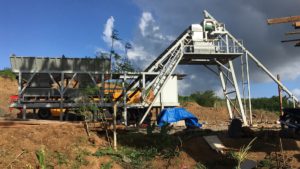Regular and routine maintenance is critical in maximizing the lifespan, downtime and replacement parts cost for all concrete plants, and the maintenance routine suggested by the manufacturer of your concrete plant should always be followed. You are encouraged to contact the manufacturer of your specific concrete plant and ask the for their specific maintenance recommendations for your plant.

Some plant manufacturers however don’t provide very good maintenance policies and some manufacturers are out of business. Other concrete plant manufactures provide unhelpful maintenance information. This blog will focus on the popular unhelpful maintenance tips offered by many concrete plant manufacturers and hopefully provide some additional insight on the topic.
ADD GREASE TO ALL GREASE FITTINGS
Some concrete plants use permanently greased fittings, but most have grease fittings on every bearing. Bearings are normally located both sides of the head and tail pully of each conveyor as well as both ends of all augers. Some augers may also include one or more bearings in the middle that may require grease. You will also find grease fittings on most motors and pumps. Carefully look around your plant. If something moves, spins, rotates or comes in contact with another metal grease is probably required.
TIGHTEN LOOSE BOLTS
No, this is not completely practical considering the hundreds of bolts on a concrete plant. You should however identify the high risk bolts and add them to your regular maintenance routine, and try to put a routine in place where lower risk bolts are checked seasonally. High risk bolts would be those bolts at or near places of impact and/or movement. Bolts found on or near gates, bearings and turnheads are generally at higher risk of loosening or failing because of the added vibration and movement in these areas.
VISUAL INSPECTION
Watch each part of the plant operate. Look and listen for things out of the ordinary. A full visual inspection of your concrete plant will take several loads. Focusing your inspection on the cement handling systems, then moving to the aggregate handling systems and onto water finishing with dust collection is a way of compartmentalizing your inspections, but will require inspection over several loads of concrete to properly inspect all parts of the concrete plant.
AIR SYSTEM INSPECTION
Your air system should be inspected as part of your regular maintenance. Remember, compressed air can be dangerous and Lock Out/Tag Out procedures should be observed when working with compressed air. Your air compressor will have its own maintenance recommendations that may include draining the tank, lubricating the motor and checking other fluids. Hoses and connections should be checked for leaking air and to make sure they are properly from damage by other moving parts. Air traps and dryers should be inspected and drained if necessary and air oilers should be properly filled and inspected for proper operation.
OTHER SYSTEMS INSPECTION
Some concrete plants include hydraulic systems, electrical generators, water treating equipment, etc. Because of the diverse nature of these system, this blog only discusses components and systems common to almost all concrete plants. If your concrete plant has additional system not included in this article like hydraulics or admixtures please consult the manufacturer or try searching for maintenance tips related specifically to those systems.
HOW FREQUENTLY SHOULD ROUTINE MAINTENANCE BE DONE?
As often as possible. Weekly is good, daily is better. It will vary between operators based on how much is produced each day and the weather conditions where the concrete plant is located. It is a safe bet however to make sure a daily inspection is completed, and if you are running high production each day you should be doing routine maintenance each day. If you are a slower production concrete plant you may be able to get away with a daily inspection weekly maintenance.